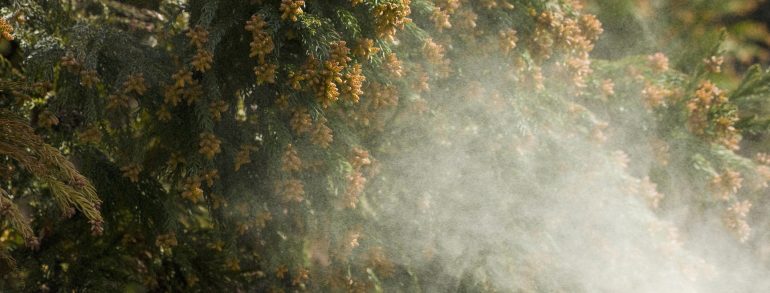Every winter season central and south Texas residents not only celebrate Christmas and ring in the New Year, but they’re also exposed to an air quality pollutant – cedar pollen.
Where does cedar pollen originate and why during the holiday season? Pollen is a plant or tree’s way of sexually reproducing itself. As pollen is released it interacts with reproductive structures of the same species which, in turn, bear seeds that are eventually dropped to the soil where they may germinate and grow into a new organism. (Just what we need – more cedar trees!) The biology of the Texas Hill Country cedar tree is such that the trees begin to produce pollen as a result of the reduced amount of sunshine with shorter daytime. San Antonio and the surrounding area’s first cold snap is the final stimulus needed for the trees to let go of their pollen. Unfortunately, this is usually accompanied by strong north winds that bring the pollen straight into our area.
Cedar pollen is a keen allergen due to high airborne concentrations and the physical shape of its outer wall. Many central and south Texans experience a histamine reaction to the airborne pollen. Symptoms are widely varied amongst individuals and can range from the extreme “cedar fever”, to coughing, sneezing, chest congestion, and irritated eyes. There are many over-the-counter antihistamines, holistic cedar remedies, and prescribed medications that may be able to help arrest reactions.
What else can y’all do to combat cedar pollen? Increasing the filtration within your indoor environment and the frequency of vacuum cleaning are two effective strategies. Increased filtration can occur in a variety of ways including exchanging your current AC filter for one of better quality. In addition, portable air filtering fans or “air purifiers” may be used to help remove the pollen from your indoor environment. If in the market for a new filter, be sure to look at the manufacturer’s efficiency rating value (MERV). The higher the number assigned to a filter, the more efficient it is. Portable filter fan units should be selected with high efficiency particulate air (HEPA) filters. Finally, make sure your vacuum cleaner also has a HEPA filter. If not, do some shopping for a new vacuum cleaner that is HEPA filter equipped. If so, perform a thorough HEPA vacuum cleaning throughout the home on each horizontal surface including curtains and drapes, furnishings, and flooring. While “cedar season” is in San Antonio, consider vacuum cleaning your home and office horizontal surfaces as frequently as possible.


